2006 SUBARU IMPREZA ECU
[x] Cancel search: ECUPage 11 of 365
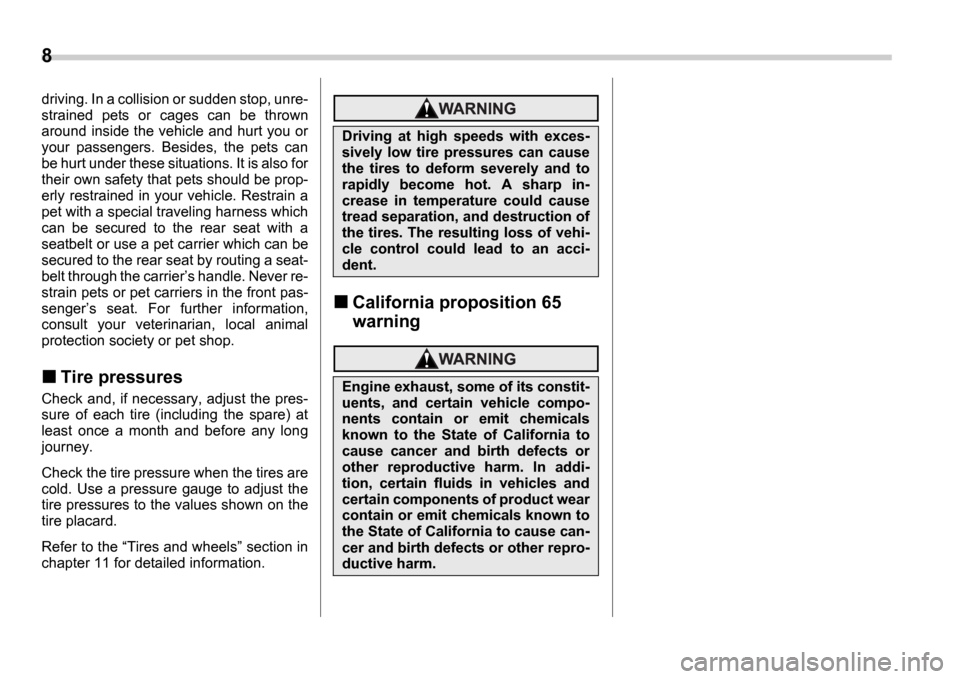
8
driving. In a collision or sudden stop, unre-
strained pets or cages can be thrown
around inside the vehicle and hurt you or
your passengers. Besides, the pets can
be hurt under these situations. It is also for
their own safety that pets should be prop-
erly restrained in your vehicle. Restrain a
pet with a special traveling harness which
can be secured to the rear seat with a
seatbelt or use a pet carrier which can be
secured to the rear seat by routing a seat-
belt through the carriers handle. Never re-
strain pets or pet carriers in the front pas-
senger s seat. For further information,
consult your veterinarian, local animal
protection society or pet shop.
Tire pressures
Check and, if necessary, adjust the pres-
sure of each tire (including the spare) at
least once a month and before any long
journey.
Check the tire pressure when the tires are
cold. Use a pressure gauge to adjust the
tire pressures to the values shown on the
tire placard.
Refer to the Tires and wheels section in
chapter 11 for detailed information.
California proposition 65
warning
Driving at high speeds with exces-
sively low tire pressures can cause
the tires to deform severely and to
rapidly become hot. A sharp in-
crease in temperature could cause
tread separation, and destruction of
the tires. The resulting loss of vehi-
cle control could lead to an acci-
dent.
Engine exhaust, some of its constit-
uents, and certain vehicle compo-
nents contain or emit chemicals
known to the State of California to
cause cancer and birth defects or
other reproductive harm. In addi-
tion, certain fluids in vehicles and
certain components of product wear
contain or emit chemicals known to
the State of California to cause can-
cer and birth defects or other repro-
ductive harm.
Page 25 of 365
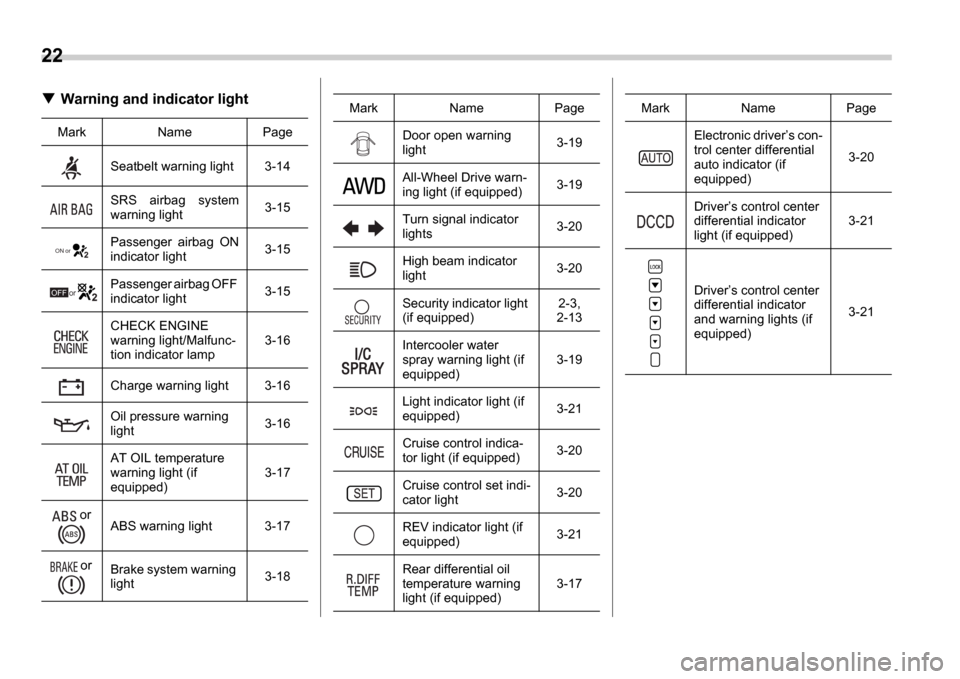
22
Warning and indicator light
Mark Name PageSeatbelt warning light 3-14
SRS airbag system
warning light 3-15
Passenger airbag ON
indicator light 3-15
Passenger airbag OFF
indicator light 3-15
CHECK ENGINE
warning light/Malfunc-
tion indicator lamp 3-16
Charge warning light 3-16
Oil pressure warning
light 3-16
AT OIL temperature
warning light (if
equipped) 3-17
or ABS warning light 3-17
or Brake system warning
light 3-18
ON or
OFF or
Door open warning
light
3-19
All-Wheel Drive warn-
ing light (if equipped) 3-19
Turn signal indicator
lights 3-20
High beam indicator
light 3-20
Security indicator light
(if equipped) 2-3,
2-13
Intercooler water
spray warning light (if
equipped) 3-19
Light indicator light (if
equipped) 3-21
Cruise control indica-
tor light (if equipped) 3-20
Cruise control set indi-
cator light 3-20
REV indicator light (if
equipped) 3-21
Rear differential oil
temperature warning
light (if equipped) 3-17
Mark Name PageElectronic driver
s con-
trol center differential
auto indicator (if
equipped) 3-20
Driver s control center
differential indicator
light (if equipped) 3-21
Driver s control center
differential indicator
and warning lights (if
equipped) 3-21
Mark Name Page
Page 29 of 365

1-2 Seat, seatbelt and SRS airbags
Seat, seatbelt and SRS airbagsFront seats
Never adjust the seat while driv-
ing to avoid the possibility of loss
of vehicle control and of personal
injury.
Before adjusting the seat, make
sure the hands and feet of rear
seat passengers are clear of the
adjusting mechanism.
Seatbelts provide maximum re-
straint when the occupant sits
well back and upright in the seat.
To reduce the risk of sliding under
the seatbelt in a collision, the
front seatbacks should be always
used in the upright position while
the vehicle is running. If the front
seatbacks are not used in the up-
right position in a collision, the
risk of sliding under the lap belt
and of the lap belt sliding up over
the abdomen will increase, and
both can result in serious internal
injury or death.
The SRS airbags deploy with con-
siderable speed and force. Occu-
pants who are out of proper posi-
tion when the SRS airbag deploys
could suffer very serious injuries.
Because the SRS airbag needs
enough space for deployment, the
driver should always sit upright
and well back in the seat as far
from the steering wheel as practi-
cal while still maintaining full ve-
hicle control and the front passen-
ger should move the seat as far
back as possible and sit upright
and well back in the seat.
100082
Put children aged 12 and under in
the rear seat properly restrained at
all times. The SRS airbag deploys
with considerable speed and force
and can injure or even kill children,
especially if they are 12 years of age
and under and are not restrained or
improperly restrained. Because chil-
dren are lighter and weaker than
adults, their risk of being injured
from deployment is greater. Conse-
quently, we strongly recommend
that ALL children (including those in
child seats and those that have out-
grown child restraint devices) sit in
the REAR seat properly restrained
at all times in a child restraint device
or in a seatbelt, whichever is appro-
priate for the child s age, height and
weight. Secure ALL types of child
restraint devices (including forward
facing child seat) in the REAR seats
at all times.
NEVER INSTALL A REARWARD
FACING CHILD SEAT IN THE FRONT
SEAT. DOING SO RISKS SERIOUS
INJURY OR DEATH TO THE CHILD
BY PLACING THE CHILD S HEAD
TOO CLOSE TO THE SRS AIRBAG.
Page 30 of 365
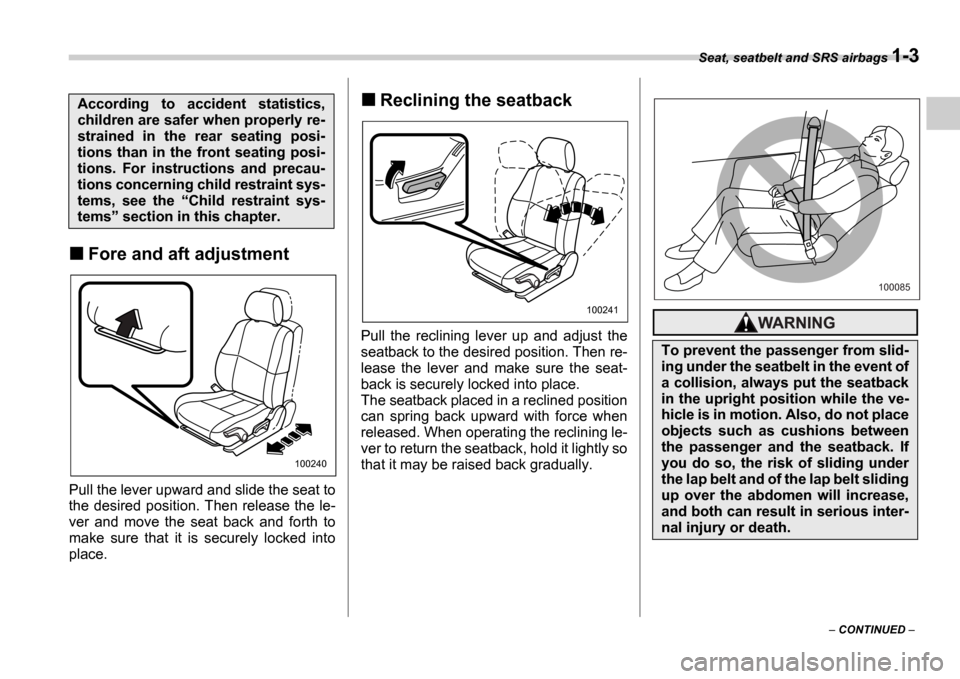
Seat, seatbelt and SRS airbags 1-3
CONTINUED
Fore and aft adjustment
Pull the lever upward and slide the seat to
the desired position. Then release the le-
ver and move the seat back and forth to
make sure that it is securely locked into
place.
Reclining the seatback
Pull the reclining lever up and adjust the
seatback to the desired position. Then re-
lease the lever and make sure the seat-
back is securely locked into place.
The seatback placed in a reclined position
can spring back upward with force when
released. When operating the reclining le-
ver to return the seatback, hold it lightly so
that it may be raised back gradually.
According to accident statistics,
children are safer when properly re-
strained in the rear seating posi-
tions than in the front seating posi-
tions. For instructions and precau-
tions concerning child restraint sys-
tems, see the Child restraint sys-
tems section in this chapter.
100240
100241
To prevent the passenger from slid-
ing under the seatbelt in the event of
a collision, always put the seatback
in the upright position while the ve-
hicle is in motion. Also, do not place
objects such as cushions between
the passenger and the seatback. If
you do so, the risk of sliding under
the lap belt and of the lap belt sliding
up over the abdomen will increase,
and both can result in serious inter-
nal injury or death.
100085
Page 34 of 365
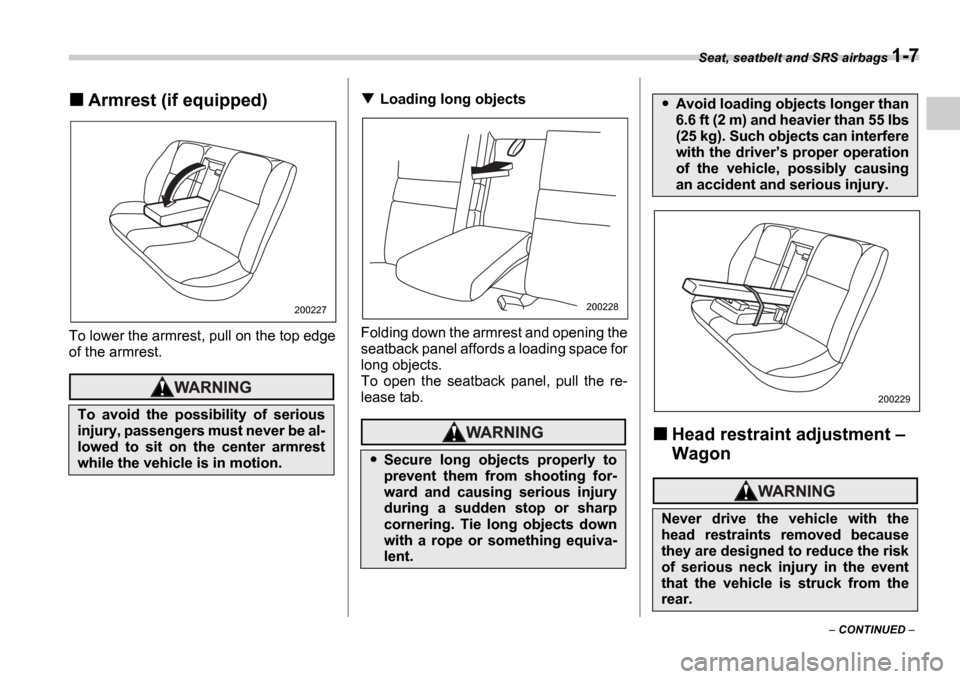
Seat, seatbelt and SRS airbags 1-7
CONTINUED
Armrest (if equipped)
To lower the armrest, pull on the top edge
of the armrest.
Loading long objects
Folding down the armrest and opening the
seatback panel affords a loading space for
long objects.
To open the seatback panel, pull the re-
lease tab.
Head restraint adjustment
Wagon
To avoid the possibility of serious
injury, passengers must never be al-
lowed to sit on the center armrest
while the vehicle is in motion.
200227
Secure long objects properly to
prevent them from shooting for-
ward and causing serious injury
during a sudden stop or sharp
cornering. Tie long objects down
with a rope or something equiva-
lent.
200228
Avoid loading objects longer than
6.6 ft (2 m) and heavier than 55 lbs
(25 kg). Such objects can interfere
with the driver s proper operation
of the vehicle, possibly causing
an accident and serious injury.
Never drive the vehicle with the
head restraints removed because
they are designed to reduce the risk
of serious neck injury in the event
that the vehicle is struck from the
rear.
200229
Page 35 of 365
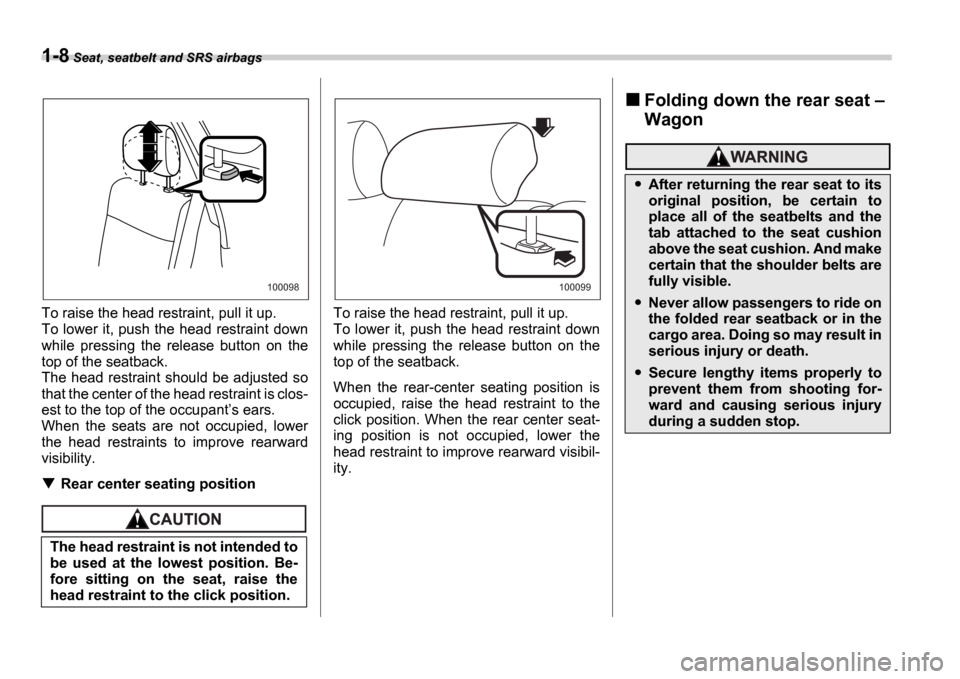
1-8 Seat, seatbelt and SRS airbags
To raise the head restraint, pull it up.
To lower it, push the head restraint down
while pressing the release button on the
top of the seatback.
The head restraint should be adjusted so
that the center of the head restraint is clos-
est to the top of the occupant s ears.
When the seats are not occupied, lower
the head restraints to improve rearward
visibility.
Rear center seating position
To raise the head restraint, pull it up.
To lower it, push the head restraint down
while pressing the release button on the
top of the seatback.
When the rear-center seating position is
occupied, raise the head restraint to the
click position. When the rear center seat-
ing position is not occupied, lower the
head restraint to improve rearward visibil-
ity.
Folding down the rear seat
Wagon
The head restraint is not intended to
be used at the lowest position. Be-
fore sitting on the seat, raise the
head restraint to the click position.
100098100099
After returning the rear seat to its
original position, be certain to
place all of the seatbelts and the
tab attached to the seat cushion
above the seat cushion. And make
certain that the shoulder belts are
fully visible.
Never allow passengers to ride on
the folded rear seatback or in the
cargo area. Doing so may result in
serious injury or death.
Secure lengthy items properly to
prevent them from shooting for-
ward and causing serious injury
during a sudden stop.
Page 36 of 365
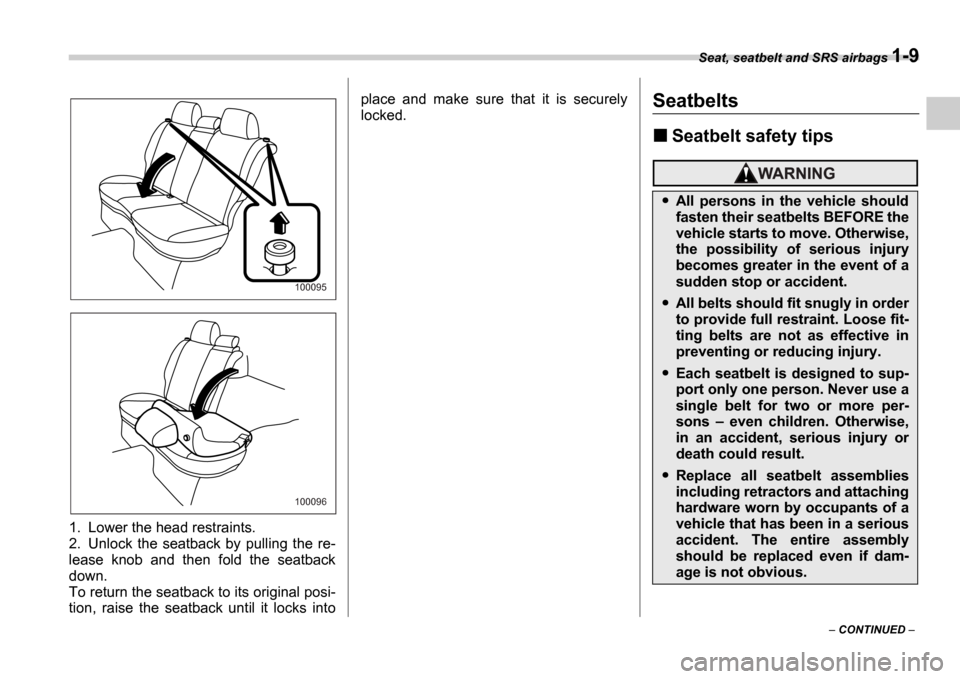
Seat, seatbelt and SRS airbags 1-9
CONTINUED
1. Lower the head restraints.
2. Unlock the seatback by pulling the re-
lease knob and then fold the seatback
down.
To return the seatback to its original posi-
tion, raise the seatback until it locks into place and make sure that it is securely
locked.
Seatbelts
Seatbelt safety tips
100095
100096
All persons in the vehicle should
fasten their seatbelts BEFORE the
vehicle starts to move. Otherwise,
the possibility of serious injury
becomes greater in the event of a
sudden stop or accident.
All belts should fit snugly in order
to provide full restraint. Loose fit-
ting belts are not as effective in
preventing or reducing injury.
Each seatbelt is designed to sup-
port only one person. Never use a
single belt for two or more per-
sons
even children. Otherwise,
in an accident, serious injury or
death could result.
Replace all seatbelt assemblies
including retractors and attaching
hardware worn by occupants of a
vehicle that has been in a serious
accident. The entire assembly
should be replaced even if dam-
age is not obvious.
Page 37 of 365

1-10 Seat, seatbelt and SRS airbags
Your vehicle is equipped with a crash
sensing and diagnostic module, which will
record the use of the seatbelt(s) by the
driver and front passenger when any of
the SRS frontal and side airbags deploys.
Infants or small children
Use a child restraint system that is suit-
able for your vehicle. See information on Child restraint systems in this chapter.
Children
If a child is too big for a child restraint sys-
tem, the child should sit in the rear seat
and be restrained using the seatbelts. Ac- cording to accident statistics, children are
safer when properly restrained in the rear
seating positions than in the front seating
positions. Never allow a child to stand up
or kneel on the seat.
If the shoulder portion of the belt crosses
the face or neck, adjust the shoulder belt
anchor height (window-side seating posi-
tions only) and then if necessary move the
child closer to the belt buckle to help pro-
vide a good shoulder belt fit. Care must be
taken to securely place the lap belt as low
as possible on the hips and not on the
child
s waist. If the shoulder portion of the
belt cannot be properly positioned, a child
restraint system should be used. Never
place the shoulder belt under the child s
arm or behind the child s back.
Put children aged 12 and under in
the rear seat properly restrained
at all times. The SRS airbag de-
ploys with considerable speed
and force and can injure or even
kill children, especially if they are
12 years of age and under and are
not restrained or improperly re-
strained. Because children are
lighter and weaker than adults,
their risk of being injured from de-
ployment is greater. Consequent-
ly, we strongly recommend that
ALL children (including those in
child seats and those that have
outgrown child restraint devices)
sit in the REAR seat properly re-
strained at all times in a child re-
straint device or in a seatbelt,
whichever is appropriate for the
child s height and weight.
Secure ALL types of child re-
straint devices (including forward
facing child seats) in the REAR
seats at all times.
NEVER INSTALL A REARWARD
FACING CHILD SEAT IN THE
FRONT SEAT. DOING SO RISKS
SERIOUS INJURY OR DEATH TO
THE CHILD BY PLACING THE
CHILD S HEAD TOO CLOSE TO
THE SRS AIRBAG.
According to accident statistics,
children are safer when properly
restrained in the rear seating posi-
tions than in the front seating po-
sitions. For instructions and pre-
cautions concerning the child re-
straint system, see the Child re-
straint systems section in this
chapter.